To the sou' west
by Rob Murton
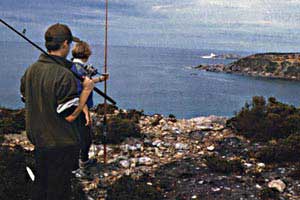
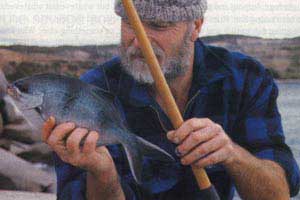
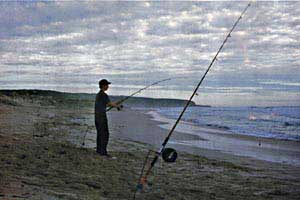
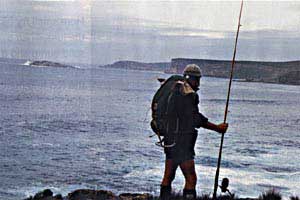
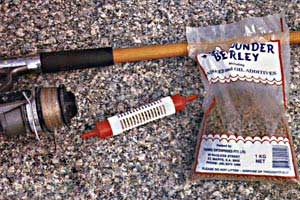
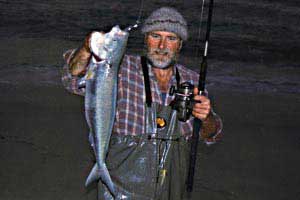
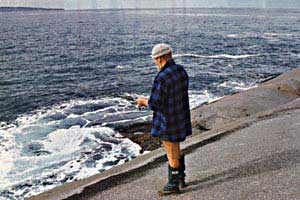 We all have a place that entices us back time after time. For me it's Hanson Bay on Kangaroo Island's south coast Situated on the western end of the island, Hanson Bay and the surrounding cliffs, scrub and rocky coves has kept me returning for close on 40 years.
We all have a place that entices us back time after time. For me it's Hanson Bay on Kangaroo Island's south coast Situated on the western end of the island, Hanson Bay and the surrounding cliffs, scrub and rocky coves has kept me returning for close on 40 years.
I have spent some good times as a youth hunting the shaggy feral goats that once inhabited the area. With my older brother Lyn and younger brother Mike, I hiked along the steep cliffs for miles and fly camped in the stunted scrub, chasing goats, fishing, catching crayfish and beachcombing.
My own two sons also spent a great deal of their childhood at Hanson Bay, or Sou'-west river as I usually call the area because that's the name of the waterway that winds its way down to the coast and empties its brackish, discoloured contents into the clear green sea during the wetter part of the year.
My wife's uncle leased a block of land on the dunes overlooking the beach and the old caravan there was a cosy refuge from the howling wind and pelting rain that often accompanied a trip to the area in winter. With the kids in tow, we took long walks along the deserted beaches.
During summer we dived, swam and fished when it was calm. Sometimes the family camped or used the caravan. Lately we have opted for a few more comforts and rented a shack for the weekend.
The south coast of Kangaroo Island is ruggedly beautiful. The beaches are white sand and fine shell grit. The cliffs are carved and worn by the savage sou'-westerly gales and driving rain.
The scrub is wind battered, gnarled and twisted by the hammering elements of nature. It's wild and rough and it has a feel like no other - standing on weathered limestone cliffs, watching the thundering green waves crash onto encrusted reef and feeling like you are the first one to witness the scene.
To the locals, Hanson Bay means salmon fishing. The small cove doesn't produce the best fishing. Head east cross a rocky headland and you come to a long wilder beach. Hanson Bay is protected by a reef, the second beach isn't. The sand troughs are ripped out by violent wave action and the beach is scoured clean by the surging sea. Above high water marks, seaweed, flotsam and the casualties of the elements - dead birds and fish - lay among the tangled debris.
My wife Pauline, son Russ and I were up on the second beach at the peak of the tide. We had arrived after lunch and stowed our gear in the shack above the cove. There was no wind, which doesn't happen often at Hanson, but the surf still crashed against the cliffs.
With pilchard baits on ganged hooks, the heavy star sinkers landed with a splash in the deep hole. Rod holders were spiked into the soft wet sand and the heavy Daiwa spinning outfit and my 3.5 metre beach rod and Alvey reel were placed at an angle, ready for the sudden strike of a feeding fish.
We waited, enjoying the late afternoon calm. The pickers were about. Smaller fish meant regular bait checks. I was down at the water's edge, throwing pilchard pieces into the briny when Russ got a strong bite and set the hooks into a reasonable salmon.
Typical of the species, the greenback fought hard, leaping and pulling against the restraining line. Russ played the struggling fish until it was surfed in on a handy wave.
Rebaiting, the rig was hurled into the foaming surf. Again the lad hiked into a good fish. I was meting to wonder what I was doing wrong. I was tailing Russ's catch in the surf when the Alvey went off drag rattling. Thinking it was a salmon, I yelled to Pauline to take the strike. Looking up, I could see that she was really struggling with the heavy surf outfit. Something on the other end was ripping line from the spool against a heavyset drag.
Running up the beach, I took the rod from my relieved wife, who was nursing a line-burnt hand. Trying to apply some pressure didn't stop the critter on the other end. There was too much line out and the reef was close. Again I attempted to apply the brakes, but whatever it was headed for the rocks and the line went slack. Ray shark, or something else? Who knows?
Towards dark we plodded back. It was hard going in waders, heaving every footstep from the clinging wet sand while lugging a pack, rod, rod holder and bait bucket. The last sand hill to the door of the shack seemed the hardest and I was glad to dump my load and have a rest. After a meal, we relaxed on the font deck overlooking the bay. The booming surf seemed louder after dark. Or it could have been the lack of wind, which magnified the clash of angry water on rock.
The next morning found us hiking the rugged cliffs to the west. Again I was packing a load, planning to visit a point we called the boulders, a jumble of huge granite monoliths and a handy low point from which to fish. The target was sweep. My brother and I discovered this spot on one of our goat hunts and we hauled up heaps of silver sided fish from the suds.
Sweep like rough water along reefs and deep drop-offs. Using heavy barley floats for distance casting, I was able to get my bait out beyond the swirling white water to where the fish were. We caught quite a few good fish, releasing most of the hard fighters, but keeping a couple for a meal.
As I stood on the cliff top looking over familiar haunts, heavy pack on my back and rod in hand, I remembered vividly the many happy days exploring this section of the coastline. Memories came to mind of cosy camps in the straggly bush, smoky fires and the rustle of our tent in the breeze and always that continuous sound, the swell of the Southern Ocean rolling onto jagged cliffs.
Things were slow back in the salmon hole that afternoon. A couple of blokes further up the beach caught one good fish, but our baits remained untouched.
It was almost dark when I replaced the hook and sinker with a Halco 40-gram chrome lure. The first half a dozen casts produced large Tommy ruffs and salmon trout up to a kilo, but nothing big. Hanson Bay is known for its big salmon and I was keen to get a photo or two of a good fish.
More small fry hit the lure. Then a solid bump and a serious curve in the rod told me that I had hooked something better. After a short, sharp, struggle, a glistening buck salmon leapt from the surging sea, doggedly resisting my best efforts to beach the fish. I waited, allowing the greenback to wear itself down a tad, until a suitable wave came along and I eased the fish up the beach and into my eager clutch. You beauty, this was more like it. The salmon weighed about seven or eight pounds in the old scale and, although they get bigger, I was more than satisfied with my catch. It was late autumn and by the middle of winter the salmon schools are fairly constant, hunting bait fish in the deep channels along the south coast. In the west, the glow of sunset cast a golden hue over the waters of the bay.
Back at the shack I was glad to be rid of clammy waders and damp clothes. A warm shower washed the smell of oily pilchards, salt and sand away.
After a meal of fresh sweep, I was lounging on the outside deck when we received a visitor. A big old brush tail possum came up to me, as bold as brass for a handout. Russ gave the hungry marsupial a crust of bread and I watched as the lad slowly extended his hand and scratched the soft fur on the possum's head. He didn't even blink, just kept on feeding. That night I slept like a baby, the surf still booming in the background.
Up before the birds, I took a lone stroll along the beach. It was so cold that steam was rising off the sea. I ended up sitting on a jutting headland overlooking the bay watching the sunrise, reminiscing and watching the surf. Soon it would be time to pack up and leave.
And the waves still rolled in, crashing and spouting salty spume high in the air. A gull screeched above the noise as the tide rose and sleek silver shadows stole into the gutters to feed. I'd be back.
